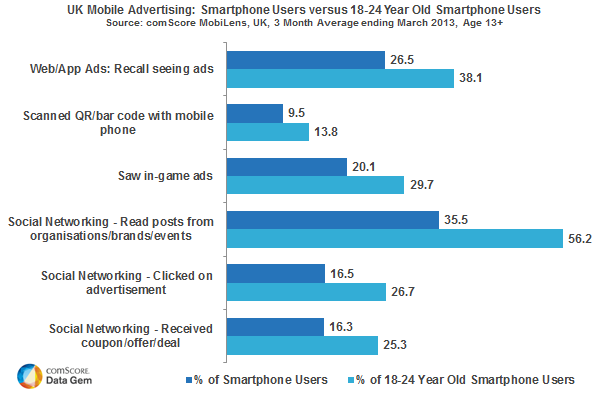
A report released by ComScore in May this year has found that young Brits have a far higher recall rate for advertisements that they saw on their mobile devices than any other type of advertising.
Smartphone penetration in the UK has reached an all-time high, with 2013 being the first year ever where global smartphone shipments have outpaced feature phone shipments. By March 2013, 67% of the UK population owned smartphones, the equivalent to over 33.4 million Brits.
The integration of smartphones into our daily lives has provided advertisers with increased opportunities to target audiences on the go, wherever they are. This increase in smartphone penetration and the frequency of usage has led to large-scale growth in the mobile advertising sector, with marketers capitalising on the advantages of localised campaign targeting and the ability to bring their brand as close to the consumer as possible, delivering a more personal advertising experience. The effectiveness and proven ROI from mobile marketing campaigns over the past several years has led to marketers re-allocating their marketing budgets to focus on this medium.
eMarketer recently highlighted in one of their studies that 69% of respondents (who were all US Brand Marketers) plan to increase their mobile marketing spend, a significant growth, particularly when compared to Standard Display which just 19% of the participants declared they would be pursuing as a tactic.
Mobile advertising has proven to be a successful means for targeting audiences; this is reflected in comScore’s study which shows that young Brits in particular have a very good recall rate for advertisements that they saw on their mobile phones. In total, 38.1% of 18-24 year-olds surveyed recalled seeing an advertisiment on their mobile phone compared to 26.5% of other smartphone users.
It appears that it is not only younger audiences in the UK which are receptive to mobile advertising. MobiAd News surveyed Chinese university students on their attitude towards mobile advertising and found that 47% of the 738 students surveyed were interested in receiving advertising on their mobile devices. Interest level jumped to 69% when the students were able to control which brands could advertise to them, suggesting that interactive advertising where consumers are able to select which video advertisement they see could become the dominant advertising format as smartphones become more integrated worldwide.
Conclusion
The research by comScore and MobiAd suggests that mobile advertising will become an increasingly viable marketing tactic for advertisers. The enhanced brand recall, combined with the knowledge that our mobile devices are our constant companions – with us wherever we go – suggests that mobile marketing will become one of the most receptive platforms from which brands can engage consumers with carefully targeted and interactive advertisements.
To find out more about mobile advertising and how it can evolve your brand campaign, take a look at our website at www.adspruce.com




